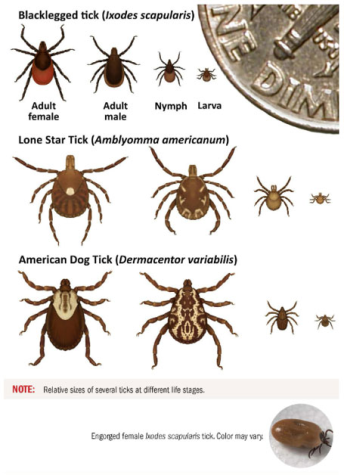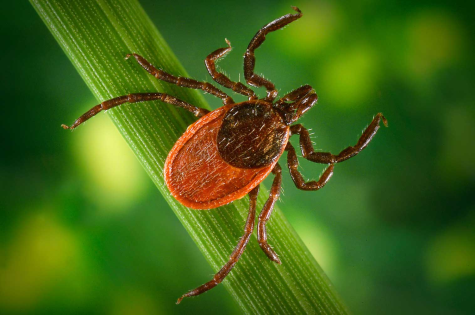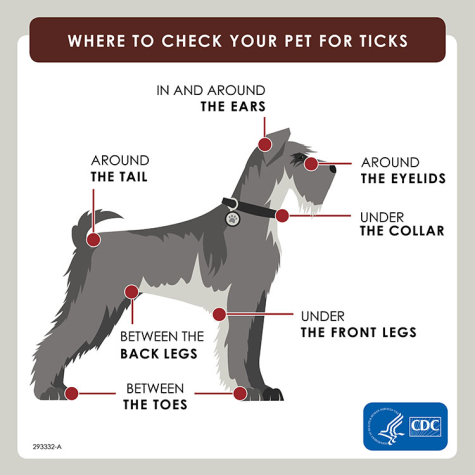How To Be Tick Smart This Summer in VT
May 26, 2023
As the air gets warmer, the ticks start to come out. In recent years, they have not been wasting any time. Here is a little information about these pesky bugs, and some things you can do to protect yourself, your family members, and your pets.

In Vermont, there are 15 species of ticks, and six of those carry disease, according to the Vermont Department of Health. Out of those six ticks, you really only need to be worried about one: the blacklegged tick.
You may also know the blacklegged tick as the deer tick. In fact, the Vermont Department of Health reports that over 99% of all reported tick-borne diseases are from the blacklegged tick.
Pathogens are what cause diseases in humans and other animals. They are parasitic microorganisms. An infected deer tick carries Borrelia burgdorferi and Borrelia mayonii (bacteria) which causes Lyme disease.
Tick Environments
Most ticks hang out in shady and damp environments, often in areas with tall grasses. They will also be on leaves and shrubs. You may be thinking, “oh, if I just walk or run fast through the grass, then I’ll be safe.” Well, that is not necessarily the case because ticks are masters at hanging on the tips of their perch and clinging onto anything that walks by.

According to the CDC, ticks wait in a position known as “questing”. They can NOT jump from grass or fall from trees, which is a common misconception. When questing, ticks grab on to their perch with their 3rd and 4th pairs of legs. Their other legs are fully stretched out waiting for their prey to walk by. This allows them to grab onto prey in an instant!
“Be Tick Smart”
First and foremost, spacing yourself from the ticks is almost 100% tick proof; this means staying inside, or if you do go outside, stay on streets or sidewalks. However, we all know this is hard to do when you live in a beautiful state like Vermont, so when you go out, follow these simple guidelines from the Vermont Department of Health:
- Protect: Use EPA registered insect repellent (preferably that has Deet), and wear light colored clothing that covers your whole body.
- Check: When back home, throw your clothes in the dryer on high heat for 10 minutes and take a shower as quickly as possible. A second look does not hurt after the shower.
- Remove: If you find a tick, remove it as soon as possible. Tweezers or a special tick removing tool will do the trick if spotted soon enough.
- Watch: Watch for the common “bullseye” which you will find at the spot where you pulled off the tick. If symptoms arise, contact your doctor ASAP.
If you do find a tick, report it to the Tick Tracker put out by the Vermont Department of Health.
Pets also fall victim to tick bites. Do not forget to check over your dog when you return from a day outside! They are especially prone to bringing in ticks and then passing them to you. It is also important to be proactive and vaccinate your pets to common diseases, but as the CDC reports, there are not vaccinations available for the majority of tick-borne diseases. This means you need to step up your game and check your pets!
Similarly to yourself, dogs will display symptoms if they have been bitten, so keep an eye out for changes in appetite and behavior in them.

As always, talk to your health care provider, and your dogs’ veterinarian, about more specific tick defenses. For example, most dogs will wear a tick collar during the most active months of the year.
Note: The CDC reports that cats are extremely sensitive to the chemicals in most tick prevention products.
Climate Change and Ticks
Our climate is changing, warming, and at a faster rate than ever recorded. In fact, as of April, 2023, “Vermont is the 9th fastest warming state in the country” according to My Champlain Valley.com. This dramatic increase in temperature is directly related to an increase in the tick population.
Warmer climates make it easier for ticks to survive year-round for a few reasons.
First, as our winters shorten, our summers grow. This allows ticks to be active for a longer period of time, giving you a higher chance of getting bitten, according to the Vermont Department of Health.
Secondly, the warmer weather gives the host organisms, such as the white-footed mouse, a better chance of survival throughout the snowy months. This gives ticks a food source all year-round, as stated by the Vermont Department of Health.
Thirdly, ticks usually are not active in freezing temperatures (below 32 degrees fahrenheit), so with less and less freezing days each year, the ticks will be out looking for hosts, including you.
The overall effect this has on our ecosystem is catastrophic. Ticks will be introduced to areas where they previously had no chance of surviving, such as higher elevations, and the areas where they already were living will continue to see a dramatic increase in population. Plus, as stated before, changes in tick populations affect not only humans and pets, but the whole food chain. If more white-footed mice and white-tailed deer get infected, that affects their predators like foxes, coyotes, and owls. If we do not take action immediately to save our climate, then we are automatically not doing anything to save Vermont and its natural beauty and safety.











